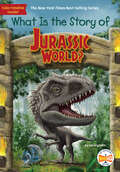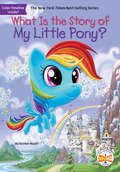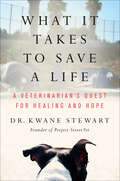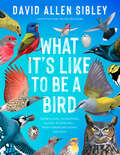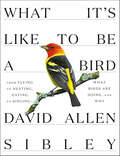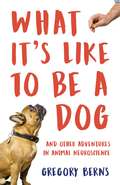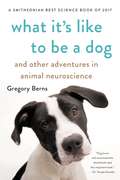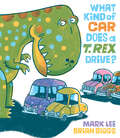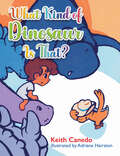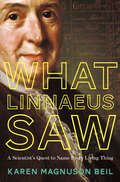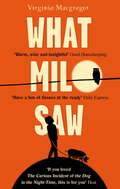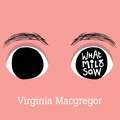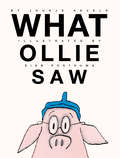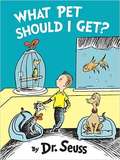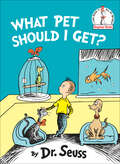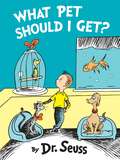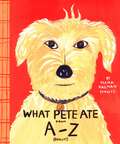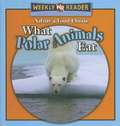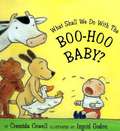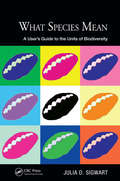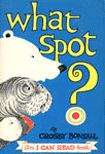- Table View
- List View
What Is the Story of Jurassic World? (What Is the Story Of?)
by Jim Gigliotti Who HQPrepare to be thrilled by an imaginary world where dinosaurs have been brought back to life and roam alongside humans in this Who HQ book all about Jurassic World!Discover the action-packed history of Jurassic World and how dinosaur fans of all ages came to love the series' movies, books, TV shows, and even theme park rides. From the 1990 Michael Crichton novel to the movies still releasing today, young readers will love stepping into this world where dinosaurs rule. The Jurassic World franchise has thrilled fans for decades by building a world where science and adventure meet, raising the question: Could dinosaurs and humans ever really live together?
What Is the Story of My Little Pony? (What Is the Story Of?)
by Kirsten Mayer Who HQWho HQ brings you the stories behind the most well-known characters of our time. In this addition to the What Is the Story Of? series, young readers will discover the exciting story of the beloved ponies, unicorns, and other fanciful characters of the My Little Pony universe!When Hasbro's pony toys first hit shelves in 1981, they were originally called My Pretty Pony. By 1982, the toys were renamed My Little Pony and the world of rainbow-colored horses with hair you could brush began capturing the hearts of children everywhere. These pony characters soon became the stars of cartoons, movies, and video games. Today, the ponies look far different than they did forty years ago, but fans of all ages are still all-in on their favorites -- including Rainbow Dash, Twilight Sparkle, Fluttershy, and Pinkie Pie -- who encourage imagination, friendship, and kindness.
What It Takes to Save a Life: A Veterinarian's Quest for Healing and Hope
by Kwane StewartMountains Beyond Mountains meets Tattoos On the Heart in this unforgettable, powerful, and stunningly-told memoir of a struggling veterinarian saving animals and humans on the streets of California - and how he discovered what bonds all living creatures.Dr. Kwane Stewart was questioning his career as a veterinarian when he saw a homeless man with a flea-infested dog outside of a convenience store. In a moment of spontaneous generosity, he offered to examine the dog and treat him for free. It was the first step in a now nine-year journey that has taken Dr. Kwane from Skid Row to San Francisco and beyond to care for pets and their humans who are living on the streets.In What It Takes to Save a Life, Dr. Kwane shows how our four-legged, feathered, scaled, and swimming family members—these dogs, cats, birds, reptiles, and other animals that live side by side with us—provide more than companionship. They offer essential love, hope, and a sense of security.Written with striking honesty and rich detail, Dr. Kwane looks back on his childhood, how he discovered his appreciation for animals and his calling, and offers a frank assessment of the state of veterinary medicine today, where compassion fatigue, burnout, and suicide are facts of life. Full of warm and inspiring stories of human-animal relationships, this powerful and eye-opening book is a reminder that we are all members of a wider family. It is also a clarion call for each of us to help those in need—especially our most vulnerable brothers and sisters—and the animals who are their families. Wise and warm, Dr. Stewart's story is a reminder that one life can make an immeasurable difference.
What It's Like to Be a Bird (Adapted for Young Readers): From Flying to Nesting, Eating to Singing--What Birds Are Doing and Why
by David Allen SibleyIn this edition for young readers adapted from the bestselling work written and illustrated by David Allen Sibley, readers will find a unique treasure trove of fascinating facts about birds, paired with more than 300 full-color illustrations—some life-size! The extraordinary world of birds is brought to life on the page. Did you know that many species of birds have sensory abilities that surpass those of humans? Or that some birds spend the entire winter in the air, and even sleep while flying? Have you ever wondered why birds have feathers? Or why they are a particular color? Have you noticed that some birdsong sounds like a musical scale?Maybe you&’re more interested in &“how&” questions: How do birds actually fly or swim? How and why do some birds migrate? How do they find food? How do they take care of their offspring?Birds are not only beautiful and fascinating, but they also serve an essential role in our ecosystem. This book shows how birds and humans are intrinsically connected, sometimes helping and sometimes hindering each other.Perfect for dedicated birdwatchers—or for anyone who simply delights in noticing birds in their neighborhood. Readers can explore, share, and return to the pages again and again, each time gaining a broader appreciation for our enchanting feathered friends.
What It's Like to Be a Bird: From Flying to Nesting, Eating to Singing--What Birds Are Doing, and Why (Sibley Guides)
by David Allen SibleyThe bird book for birders and nonbirders alike that will excite and inspire by providing a new and deeper understanding of what common, mostly backyard, birds are doing--and why"Can birds smell?" "Is this the same cardinal that was at my feeder last year?" "Do robins 'hear' worms?" In What It's Like to Be a Bird, David Sibley answers the most frequently asked questions about the birds we see most often. This special, large-format volume is geared as much to nonbirders as it is to the out-and-out obsessed, covering more than two hundred species and including more than 330 new illustrations by the author. While its focus is on familiar backyard birds--blue jays, nuthatches, chickadees--it also examines certain species that can be fairly easily observed, such as the seashore-dwelling Atlantic puffin. David Sibley's exacting artwork and wide-ranging expertise bring observed behaviors vividly to life. (For most species, the primary illustration is reproduced life-sized.) And while the text is aimed at adults--including fascinating new scientific research on the myriad ways birds have adapted to environmental changes--it is nontechnical, making it the perfect occasion for parents and grandparents to share their love of birds with young children, who will delight in the big, full-color illustrations of birds in action. Unlike any other book he has written, What It's Like to Be a Bird is poised to bring a whole new audience to David Sibley's world of birds.
What It's Like to Be a Dog: And Other Adventures in Animal Neuroscience
by Gregory BernsWhat does your dog really think about you? To find out, Gregory Berns became the first neuroscientist to persuade dogs to lie in an MRI machine wide awake. Now we know more about our best friends than ever before – how varying capacities for self-control and different value systems set them apart as individuals, and how deeply they understand the words we speak to them. Berns&’ discoveries have profound implications for how we communicate with and treat these beloved animals. But he didn&’t stop there. Berns also delves into the inner lives of sea lions, bats, dolphins, and even the extinct Tasmanian tiger. His revolutionary explorations are essential reading for animal lovers of all stripes.
What It's Like to Be a Dog: And Other Adventures in Animal Neuroscience
by Gregory BernsA pathbreaking neuroscientist discovers the link between human and animal mindsWhat is it like to be a dog? A bat? Or a dolphin? To find out, neuroscientist Gregory Berns and his team began with a radical step: they taught dogs to go into an MRI scanner--completely awake. They discovered what makes dogs individuals with varying capacities for self-control, different value systems, and a complex understanding of human speech. And dogs were just the beginning. In What It's Like to Be a Dog, Berns explores the fascinating inner lives of wild animals from dolphins and sea lions to the extinct Tasmanian tiger. Much as Silent Spring transformed how we thought about the environment, so What It's Like to Be a Dog will fundamentally reshape how we think about--and treat--animals. Groundbreaking and deeply humane, it is essential reading for animal lovers of all stripes.
What Kind of Car Does a T. Rex Drive?
by Mark LeeDinosaurs find their ideal vehicles in this hilarious, crowd-pleasing read-aloud, perfect for fans of Dragons Love Tacos and Goodnight, Goodnight, Construction Site. It's the perfect gift for dinosaur lovers and fans of cars, trucks, and all things that go!When a stegosaurus, a pterodactyl, and a triceratops all show up at Uncle Otto's car lot, he doesn't have a clue how to help them. After all, he's never sold a car to a dinosaur before. Luckily, Ava and Mickey--two kids with a lot of dino knowledge--are there to help pair each customer with the perfect vehicle. But here comes the T. Rex, and he wants to buy a car too! And he's surprisingly hard to please... So what kind of car does a T. Rex drive? A microcar? A convertible? A minivan? You'll just have to read to find out!"A delightful blend of dinosaurs with things that go, sure to entertain aficionados of both." --Booklist"Only the extinct would fail to enjoy this kicky amalgamation of dinos, deals, and automobiles." --Kirkus Reviews"Smashed cars, expert kids, dinosaurs! Customer satisfaction guaranteed!" --The Horn Book Magazine
What Kind of Dinosaur Is That?
by Keith CanedoJacob is in the hospital.The Bronchitis stepped up, handing Jacob a letter. &“We are your friends and we hope you feel better.&”&“Just do what they say and you&’ll be good as new. And together with love, we will all see you through.&”
What Linnaeus Saw: A Scientist And His Quest To Name And Catalog Every Living Thing
by Karen Magnuson BeilThe globetrotting naturalists of the eighteenth century were the geeks of their day: innovators and explorers who lived at the intersection of science and commerce. Foremost among them was Carl Linnaeus, a radical thinker who revolutionized biology. In What Linnaeus Saw, Karen Magnuson Beil chronicles Linnaeus’s life and career in readable, relatable prose. As a boy, Linnaeus hated school and had little interest in taking up the religious profession his family had chosen. Though he struggled through Latin and theology classes, Linnaeus was an avid student of the natural world and explored the school’s gardens and woods, transfixed by the properties of different plants. At twenty-five, on a solo expedition to the Scandinavian Mountains, Linnaeus documented and described dozens of new species. As a medical student in Holland, he moved among leading scientific thinkers and had access to the best collections of plants and animals in Europe. What Linnaeus found was a world with no consistent system for describing and naming living things—a situation he methodically set about changing. The Linnaean system for classifying plants and animals, developed and refined over the course of his life, is the foundation of modern scientific taxonomy, and inspired and guided generations of scientists. What Linnaeus Saw is rich with biographical anecdotes—from his attempt to identify a mysterious animal given him by the king to successfully growing a rare and exotic banana plant in Amsterdam to debunking stories of dragons and phoenixes. Thoroughly researched and generously illustrated, it offers a vivid and insightful glimpse into the life of one of modern science’s founding thinkers.
What Lives in a Shell (Let's Read And Find Out)
by Kathleen Weidner ZoehfeldDescribes such animals as snails, turtles, and crabs, which live in shells and use coverings as protection
What Lives in a Shell? (Let's-Read-and-Find-Out Science 1)
by Kathleen Weidner ZoehfeldRead and find out about what lives in a shell in this colorfully illustrated nonfiction picture book.A house is a home for you, a nest is a home for a bird, and a cave is a home for a bear. But for some animals a shell is a home. Snails and turtles and crabs and clams all have shells that act as their homes and protect them from harm.This clear and appealing book for early elementary age kids, both at home and in the classroom, is a fascinating exploration of the many creatures that make a home in a shell. This picture book features beautifully accurate illustrations of the many types of shells—inside and out! Young readers will love exploring the fascinating homes of creatures like hermit crabs, scallops, and turtles.This is a Level 1 Let's-Read-and-Find-Out, which means the book explores introductory concepts perfect for children in the primary grades. The 100+ titles in this leading nonfiction series are:hands-on and visualacclaimed and trustedgreat for classroomsTop 10 reasons to love LRFOs:Entertain and educate at the same timeHave appealing, child-centered topicsDevelopmentally appropriate for emerging readersFocused; answering questions instead of using survey approachEmploy engaging picture book quality illustrationsUse simple charts and graphics to improve visual literacy skillsFeature hands-on activities to engage young scientistsMeet national science education standardsWritten/illustrated by award-winning authors/illustrators & vetted by an expert in the fieldOver 130 titles in print, meeting a wide range of kids' scientific interestsBooks in this series support the Common Core Learning Standards, Next Generation Science Standards, and the Science, Technology, Engineering, and Math (STEM) standards. Let's-Read-and-Find-Out is the winner of the American Association for the Advancement of Science/Subaru Science Books & Films Prize for Outstanding Science Series.
What Makes a Monster?: Discovering the World's Scariest Creatures (The World of Weird Animals)
by Jess KeatingMonsters are real—and they're everywhere in nature! Animal Planet meets Godzilla in this nonfiction picture book that puts the "Ack!" into backyard science. Some people think monsters are the stuff of nightmares—the stuff of scary movies and Halloween. But monsters can also be found right in your backyard. Animals like aye-ayes, goblin sharks and vampire bats may look scary, but they pose no threat to humans. Others, such as the prairie dog, seem innocent—cute, even—yet their behavior could give you goose bumps. What makes a monster? Read this book to find out, if you dare. . . . Jess Keating and David DeGrand, the author illustrator team behind Pink Is for Blobfish will have readers shrieking with laughter at this latest installment to the World of Weird Animals series.
What Milo Saw: He sees the world in a very special way . . .
by Virginia MacgregorPrepare to fall in love 'A future classic' Clare Mackintosh'We were hooked . . . Brilliant!' Heat 'Have a box of tissues at the ready' Daily Express'A life-affirming read' Good Housekeeping'You'll fall in love with Milo!' Company'Sharp, funny and hugely moving' Fabulous'Might restore your faith in human nature' Bella'Absolutely delightful' Novelicious If you loved The Curious Incident of the Dog in the Night-Time or The Trouble With Goats and Sheep this is the book for you.You Found Me by Virginia Macgregor is OUT NOW********************************************Nine-year-old Milo Moon has retinitis pigmentosa: his eyes are slowly failing, and he will eventually go blind. But for now he sees the world through a pin hole and notices things other people don't. When Milo's beloved gran succumbs to dementia and moves into a nursing home, Milo soon realises there's something wrong at the home. So with just Tripi, the nursing home's cook, and Hamlet, his pet pig, to help, Milo sets out on a mission to expose the nursing home...MORE PRAISE FOR VIRGINIA MACGREGOR...'Will delight you but break your heart several times over' Sun'I couldn't put this insightful, compelling novel down' Woman & Home'Deeply satisfying' Sarra Manning, Red 'Sharp, funny and hugely moving . . . a must read' Fabulous'Warm, wise and insightful' Good Housekeeping 'Beautifully written and thought-provoking, this is a brilliant read' Sun'This wonderful story will tear at your heart.' My Weekly 'Brilliant!' Heat 'A poignant and very clever read' Company'A truly heart-warming story of family, love and loyalty' Daily Express'An astonishingly brilliant novel' Australian Women's Weekly'A touching look at the meaning of motherhood' Good Housekeeping 'A challenging and moving story about the power of love' Image'Absolutely delightful . . . Everyone should read this book!' Novelicious'Written with plenty of heart' Sunday Mirror'An emotional and powerful family drama' Heat'So engaging and powerful' Press Association 'Layered and lyrical' Irish Independent
What Milo Saw: He sees the world in a very special way . . .
by Virginia MacgregorPrepare to fall in love 'A future classic' Clare Mackintosh'We were hooked . . . Brilliant!' Heat 'Have a box of tissues at the ready' Daily Express'A life-affirming read' Good Housekeeping'You'll fall in love with Milo!' Company'Sharp, funny and hugely moving' Fabulous'Might restore your faith in human nature' Bella'Absolutely delightful' Novelicious If you loved The Curious Incident of the Dog in the Night-Time or The Trouble With Goats and Sheep this is the book for you.You Found Me by Virginia Macgregor is OUT NOW********************************************Nine-year-old Milo Moon has retinitis pigmentosa: his eyes are slowly failing, and he will eventually go blind. But for now he sees the world through a pin hole and notices things other people don't. When Milo's beloved gran succumbs to dementia and moves into a nursing home, Milo soon realises there's something wrong at the home. So with just Tripi, the nursing home's cook, and Hamlet, his pet pig, to help, Milo sets out on a mission to expose the nursing home...MORE PRAISE FOR VIRGINIA MACGREGOR...'Will delight you but break your heart several times over' Sun'I couldn't put this insightful, compelling novel down' Woman & Home'Deeply satisfying' Sarra Manning, Red 'Sharp, funny and hugely moving . . . a must read' Fabulous'Warm, wise and insightful' Good Housekeeping 'Beautifully written and thought-provoking, this is a brilliant read' Sun'This wonderful story will tear at your heart.' My Weekly 'Brilliant!' Heat 'A poignant and very clever read' Company'A truly heart-warming story of family, love and loyalty' Daily Express'An astonishingly brilliant novel' Australian Women's Weekly'A touching look at the meaning of motherhood' Good Housekeeping 'A challenging and moving story about the power of love' Image'Absolutely delightful . . . Everyone should read this book!' Novelicious'Written with plenty of heart' Sunday Mirror'An emotional and powerful family drama' Heat'So engaging and powerful' Press Association 'Layered and lyrical' Irish Independent
What Ollie Saw
by Joukje AkveldOllie doesn't see things the same way everybody else does (and he certainly doesn't see things the same way his older sister does). Instead of cars in traffic, Ollie sees a circus parade. Instead of cows grazing in a field, Ollie sees deadly bison with sharp horns and hooves. And at school, instead of letters on the board, Ollie sees birds with pointy beaks, and fish with flapping tails in the big blue sea.Ollie knows he doesn't need glasses, because he likes the world better the way he sees it. But will his parents and bossy sister see things his way?
What Pet Should I Get?
by Dr SeussThis never-ever-before-seen picture book by Dr. Seuss about making up one's mind is the literary equivalent of buried treasure! What happens when a brother and sister visit a pet store to pick a pet? Naturally, they can't choose just one! <P><P> The tale captures a classic childhood moment--choosing a pet--and uses it to illuminate a life lesson: that it is hard to make up your mind, but sometimes you just have to do it! <P> Told in Dr. Seuss's signature rhyming style, this is a must-have for Seuss fans and book collectors, and a perfect choice for the holidays, birthdays, and happy occasions of all kinds. <P> An Editor's Note at the end discusses Dr. Seuss's pets, his creative process, and the discovery of the manuscript and illustrations for What Pet Should I Get?
What Pet Should I Get? (Beginner Books)
by Dr. SeussPick a pet with Dr. Seuss with this bestselling and silly tail of cats, dogs and more! A dog or a cat? A fish or a bird? Or maybe a crazy creature straight from the mind of Dr. Seuss! Which pet would YOU get? A trip to the pet store turns into a hilarious struggle when two kids must choose one pet to take home... but everytime they think they see an animal they like, they find something even better! Perfect for animal lovers and Seuss lover alike, this book will delight readers young and old. Discovered 22 years after Dr. Seuss's death, the unpublished manuscript and sketches for What Pet Should I Get? were previously published as a 48-page jacketed hardcover with 8 pages of commentary. This unjacketed Beginner Book edition features the story only. The cat? Or the dog? The kitten? The pup? Oh, boy! It is something to make a mind up. Beginner Books are fun, funny, and easy to read! Launched by Dr. Seuss in 1957 with the publication of The Cat in the Hat, this beloved early reader series motivates children to read on their own by using simple words with illustrations that give clues to their meaning. Featuring a combination of kid appeal, supportive vocabulary, and bright, cheerful art, Beginner Books will encourage a love of reading in children ages 3–7.
What Pet Should I Get? (Classic Seuss)
by Dr. SeussA #1 New York Times bestseller! This previously never-before-seen picture book by Dr. Seuss about making up one&’s mind is the literary equivalent of buried treasure! What happens when a brother and sister visit a pet store to pick a pet? Naturally, they can&’t choose just one! The tale captures a classic childhood moment—choosing a pet—and uses it to illuminate a life lesson: that it is hard to make up your mind, but sometimes you just have to do it! Told in Dr. Seuss&’s signature rhyming style, this is a must-have for Seuss fans and book collectors, and a perfect choice for the holidays, birthdays, and happy occasions of all kinds. An Editor&’s Note at the end discusses Dr. Seuss&’s pets, his creative process, and the discovery of the manuscript and illustrations for What Pet Should I Get?
What Pete Ate from A to Z
by Maira KalmanIs there anything Pete won't eat? Poppy Wise's sweet but unruly dog starts with Nico's accordion and works his way through the alphabet, making a nuisance of himself by leaving nothing untouched, not even glue sticks or Uncle Norman's underpants. Despite Pete's ravenous ways, a frazzled Poppy Wise can't help loving him. Kids will laugh at Pete's impossible cuisine, adults will appreciate the offbeat sense of humor, and both will love the artwork that perfectly captures the fun of the text in this unique alphabet book only Maira Kalman could create.
What Polar Animals Eat
by Joanne MatternLearning about food chains and the interdependence of living things is an important part of the early science curriculum. This series uses simple text, full-color photographs, and a food chain diagram in each book to introduce these concepts. The high-interest subject matter will capture young readers' attention. The text, which has been vetted by both a science curriculum consultant and a reading consultant, will build students' reading skills as they discover how plants and animals depend on each other for survival.
What Shall We Do With the Boo-Hoo Baby?
by Cressida CowellFour animal friends do everything they can, from playing with the baby to feeding the baby, to get a baby to stop crying. This book includes picture illustrations.
What Species Mean: A User's Guide to the Units of Biodiversity (Species and Systematics)
by Julia D. SigwartEveryone uses species. All human cultures, whether using science or not, name species. Species are the basic units for science, from ecosystems to model organisms. Yet, there are communication gaps between the scientists who name species, called taxonomists or systematists, and those who use species names—everyone else. This book opens the "black box" of species names, to explain the tricks of the name-makers to the name-users. Species are real, and have macroevolutionary meaning, and it follows that systematists use a broadly macroevolution-oriented approach in describing diversity. But scientific names are used by all areas of science, including many fields such as ecology that focus on timescales more dominated by microevolutionary processes. This book explores why different groups of scientists understand and use the names given to species in very different ways, and the consequences for measuring and understanding biodiversity. Key selling features: Explains the modern, multi-disciplinary approach to studying species evolution and species discovery, and the role of species names in diverse fields throughout the life sciences Documents the importance and urgent need for high-quality taxonomic work to address today’s most pressing problems Summarises controversies in combining different—sometimes quite different—datasets used to estimate global biodiversity Focusses throughout on a central theme—the disconnect between the makers and the users of names—and seeks to create the rhetorical foundation needed to bridge this disconnect Anticipates the future of taxonomy and its role in studies of global biodiversity
What Spot? (I Can Read #Level 1)
by Crosby BonsallWhen is a spot not a spot? It depends whom you listen to -the walrus or the puffin. This hilarious tale by the author of such popular I CAN READ Books as who's a pest? and tell me some more answers this perfectly logical question with wit, charm, and high good humor. It was the walrus who first saw the spot-a black spot in the white, white snow. He would have investigated it at once had not the puffin-a know-it-all bird of diminutive stature-insisted that it was nothing, nothing at all. And the walrus had great respect for the puffin's intellect-up to a point. In uproarious words and pictures, Mrs. Bonsall describes just what happens when nothing turns out to be a very definite something. Beginning readers, when they stop laughing long enough to read the words, will find this book utterly and completely satisfying. Picture descriptions are included when they help explain what's going on in the story.
